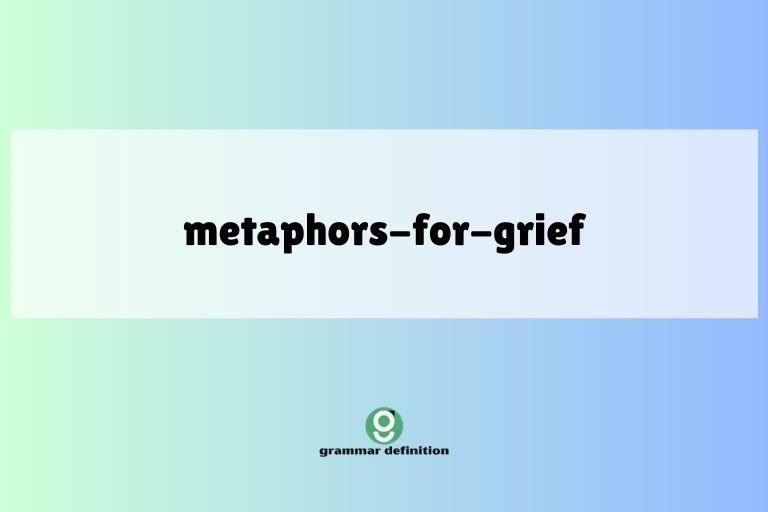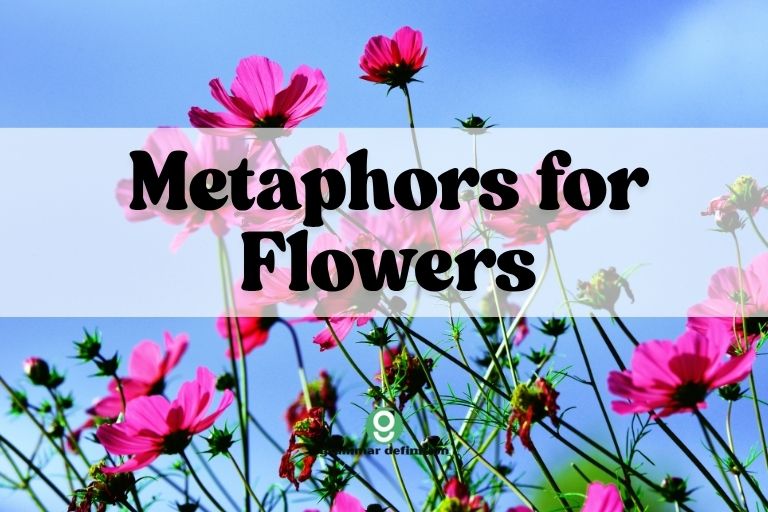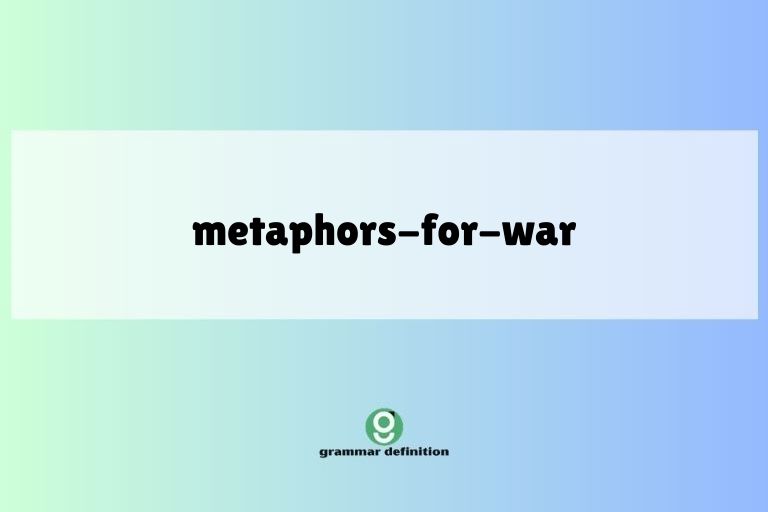Metaphors for Grief: Understanding Loss Through Language

Grief, a universal human experience, is often difficult to articulate. Language, while powerful, can sometimes fall short in capturing the depth and complexity of sorrow.
This is where metaphors become invaluable. By using metaphors, we can express the inexpressible, making grief more tangible and understandable, both for ourselves and for others.
This article delves into the world of metaphors for grief, exploring their various forms, functions, and how they enrich our understanding of loss. Whether you are a writer seeking to convey grief with greater nuance, a student of language interested in figurative expression, or simply someone trying to navigate your own or others’ grief, this guide offers valuable insights into the language of sorrow.
Table of Contents
- Introduction
- Definition of Metaphor and Grief
- Structural Breakdown of Grief Metaphors
- Types of Metaphors for Grief
- Examples of Metaphors for Grief
- Usage Rules for Metaphors in Describing Grief
- Common Mistakes When Using Metaphors for Grief
- Practice Exercises
- Advanced Topics: Grief and Figurative Language
- Frequently Asked Questions
- Conclusion
Definition of Metaphor and Grief
To understand how metaphors are used to describe grief, it’s essential to define both terms clearly. A metaphor is a figure of speech that compares two unlike things without using “like” or “as,” while grief is a complex emotional response to loss.
What is a Metaphor?
A metaphor is a figure of speech that directly compares two unrelated things, asserting that one thing *is* another. Unlike similes, which use words like “like” or “as” to make comparisons, metaphors create a direct association. This association allows us to understand something abstract or complex in terms of something more concrete or familiar. Metaphors enrich language, adding depth and layers of meaning beyond literal interpretation. They enable us to see the world in new ways and express ideas with greater impact and creativity. Consider the phrase “Time is a thief.” This metaphor doesn’t literally mean time steals things, but it conveys the feeling that time passes quickly and takes away precious moments.
Understanding Grief
Grief is the natural emotional response to loss. It’s a multifaceted experience that can encompass a wide range of feelings, including sadness, anger, confusion, disbelief, and acceptance. Grief is not a linear process; individuals may experience these emotions in different orders and intensities. The experience of grief is deeply personal and influenced by factors such as the nature of the loss, the individual’s personality, cultural background, and support system. It is important to recognize that grief is a normal and healthy reaction to loss, and there is no “right” or “wrong” way to grieve. Understanding grief involves acknowledging its complexity and allowing individuals the space and support to navigate their unique grieving process.
Structural Breakdown of Grief Metaphors
Understanding the structure of metaphors helps to analyze how they function in the context of grief. This involves identifying the source domain, the target domain, and the mapping between them.
Source Domain
The source domain is the concept or idea that is used to understand the target domain. It is usually something familiar and concrete. In the context of grief metaphors, common source domains include physical burdens, weather phenomena, journeys, and physical wounds. For example, if we say “Grief is a heavy weight,” the source domain is “heavy weight,” which is a tangible, physical experience. The clarity and familiarity of the source domain are crucial for effectively conveying the intended meaning about the target domain.
Target Domain
The target domain is the concept or idea that is being understood or described. In the case of metaphors for grief, the target domain is always grief itself – the complex emotional experience of loss. Grief, being an abstract and often overwhelming emotion, benefits greatly from being expressed through more concrete and relatable terms provided by the source domain. The goal is to make the intangible feelings of grief more accessible and understandable through the metaphorical comparison.
Mapping
Mapping is the process of connecting the attributes and characteristics of the source domain to the target domain. This involves identifying the similarities between the two and using them to create a meaningful comparison. For example, when we say “Grief is a heavy weight,” the mapping involves connecting the physical sensation of carrying a heavy weight (burden, difficulty, fatigue) to the emotional experience of grief (burden, difficulty, fatigue). Effective mapping ensures that the metaphor resonates with the audience and accurately conveys the intended meaning. The strength of the metaphor lies in the clarity and relevance of this mapping process.
Types of Metaphors for Grief
Metaphors for grief can be categorized based on the source domain they draw from. Here are some common types:
Grief as a Physical Burden
This type of metaphor portrays grief as a tangible weight or burden that one carries. It emphasizes the heaviness and fatigue associated with the grieving process.
Examples include “a weight on my shoulders,” “a heavy heart,” and “carrying the burden of sorrow.” These metaphors highlight the physical and emotional toll that grief takes on an individual.
Grief as Emotional Weather
This category uses weather-related terms to describe the emotional state of grief. It captures the fluctuating and unpredictable nature of grief.
Examples include “a storm of emotions,” “a dark cloud hanging over me,” and “the sunshine has gone from my life.” These metaphors convey the intensity and variability of grief, as well as its ability to overshadow one’s life.
Grief as a Journey
This type of metaphor frames grief as a journey or path that one must navigate. It emphasizes the process of moving through grief and the challenges encountered along the way.
Examples include “a long and winding road,” “lost in the wilderness of grief,” and “taking one step at a time.” These metaphors highlight the idea that grief is a process that requires time, effort, and resilience.
Grief as Absence or Emptiness
These metaphors focus on the void left by the loss of a loved one. They highlight the feeling of emptiness and the missing presence.
Examples include “an empty chair,” “a hole in my heart,” and “a vacant space.” These metaphors underscore the profound sense of loss and the enduring impact of the absence.
Grief as a Wound
This metaphor likens grief to a physical wound that needs time to heal. It emphasizes the pain and vulnerability associated with grief.
Examples include “a deep wound,” “a raw nerve,” and “a scar that never fully fades.” These metaphors highlight the healing process and the idea that grief can leave lasting marks.
Examples of Metaphors for Grief
To further illustrate the different types of metaphors for grief, here are some examples organized by category:
Grief as a Physical Burden Examples
The following table provides examples of metaphors that describe grief as a physical burden. These metaphors emphasize the weight and heaviness associated with the grieving process.
| Metaphor | Explanation |
|---|---|
| “Grief is a heavy cloak.” | Grief feels like a heavy garment weighing you down. |
| “I carry the weight of his absence.” | The absence of the person is a burden to bear. |
| “Sorrow is a stone in my pocket.” | Sorrow is a constant, cumbersome presence. |
| “Her grief was a leaden blanket.” | Grief felt heavy and suffocating. |
| “The loss is a crushing blow.” | The loss is overwhelming and debilitating. |
| “He was weighed down by despair.” | Despair made him feel physically heavy and burdened. |
| “She bore the burden of her grief silently.” | She carried her grief without sharing it. |
| “The pain was a physical ache.” | The emotional pain manifested as physical discomfort. |
| “Grief sits heavily on my chest.” | Grief creates a feeling of pressure and weight in the chest. |
| “His heart felt like a block of ice.” | His heart felt cold and heavy with grief. |
| “She felt chained to her sorrow.” | Her sorrow restricted her freedom and movement. |
| “Grief is a crushing weight on my soul.” | Grief is an unbearable burden that affects the spirit. |
| “The memory of him is a heavy anchor.” | The memory of him holds her back and weighs her down. |
| “His absence is a constant, heavy presence.” | Even though he’s gone, his missing presence is felt profoundly. |
| “She trudged through the days, burdened by grief.” | Each day felt like a struggle due to the weight of her grief. |
| “Grief pressed down on him like a physical force.” | The feeling of grief had a tangible, oppressive quality. |
| “His sorrow was a palpable weight in the room.” | The sorrow was so intense it felt like a physical presence. |
| “She felt buried under the weight of her loss.” | The loss was so overwhelming it felt as if she was being suffocated. |
| “The grief was a heavy toll on his health.” | The emotional strain of grief had a negative impact on his physical well-being. |
| “He carried his grief like a sack of stones.” | His grief was a constant, cumbersome burden he had to carry. |
| “Grief is a heavy chain that binds me to the past.” | Grief restricts her ability to move forward and feel free. |
| “The world felt like it was pressing down on her, heavy with grief.” | The world seemed overwhelming and oppressive due to her grief. |
| “He felt the full weight of his loss bearing down on him.” | The intense feeling of loss oppressed him. |
| “The pain of her absence was a heavy load to bear.” | The sorrow caused by her absence was difficult to endure. |
| “Grief felt like a physical burden, a heavy weight that never lifted.” | The pain and sorrow felt tangible and unending. |
Grief as Emotional Weather Examples
The following table provides examples of metaphors that describe grief using weather-related terms. These metaphors capture the fluctuating and unpredictable nature of grief.
| Metaphor | Explanation |
|---|---|
| “A storm of grief raged within her.” | Her grief was intense and turbulent. |
| “The dark clouds of sorrow lingered.” | Sorrow persisted and overshadowed her life. |
| “She weathered the storm of grief.” | She endured and survived the difficult period of grief. |
| “A wave of sadness washed over him.” | He was suddenly overwhelmed by sadness. |
| “The rain of tears never seemed to stop.” | She cried continuously and excessively. |
| “His heart was shrouded in fog.” | He felt confused and disoriented by grief. |
| “A cold wind of despair blew through her.” | She felt a chilling sense of hopelessness. |
| “The sunshine of her life had been eclipsed.” | Happiness and joy had disappeared from her life. |
| “Grief is a long, cold winter.” | Grief is a prolonged period of sadness and hardship. |
| “The floodgates of emotion opened.” | She experienced an overwhelming release of emotions. |
| “A gentle breeze of remembrance stirred.” | A pleasant memory brought a moment of peace. |
| “The sky of her heart was overcast with grief.” | Her heart was filled with sadness and sorrow. |
| “He was drowning in a sea of sorrow.” | He was overwhelmed and consumed by his sadness. |
| “The sun peeked through the clouds of grief.” | A glimmer of hope or happiness emerged amidst the sorrow. |
| “Her grief was a torrential downpour.” | Her grief was intense and overwhelming. |
| “The fog of grief made it hard to see clearly.” | Grief clouded her judgment and perception. |
| “His tears were like a never-ending drizzle.” | He cried frequently and consistently. |
| “She felt like a leaf tossed about in a storm of grief.” | She felt helpless and at the mercy of her emotions. |
| “The thunder of grief echoed through her mind.” | The intensity of her grief reverberated within her. |
| “His grief was a slow, steady rain, eroding his spirit.” | His grief was a persistent force that gradually weakened him. |
| “The storm inside her raged on, relentless and unforgiving.” | Her intense emotions continued without pause. |
| “She was lost in the fog of her grief, unable to find her way.” | She was confused and disoriented by her grief. |
| “The clouds of grief hung heavy, threatening to unleash another downpour of tears.” | The sadness was always present and could easily trigger more crying. |
| “A gentle rain of memories softened the harsh landscape of grief.” | Pleasant memories brought a sense of comfort and eased the pain. |
| “The hurricane of grief tore through her life, leaving devastation in its wake.” | Her grief was incredibly destructive and life-altering. |
Grief as a Journey Examples
The following table provides examples of metaphors that describe grief as a journey. These metaphors emphasize the process of moving through grief and the challenges encountered along the way.
| Metaphor | Explanation |
|---|---|
| “Grief is a long and winding road.” | Grief is a lengthy and unpredictable process. |
| “She was lost in the wilderness of grief.” | She felt disoriented and isolated in her grief. |
| “He navigated the treacherous path of mourning.” | He faced the difficulties and challenges of mourning. |
| “Grief is a journey with no map.” | Grief is an uncharted and uncertain process. |
| “She embarked on a journey through sorrow.” | She began the process of experiencing and processing her sorrow. |
| “He was walking through a dark tunnel of grief.” | He felt trapped and hopeless in his grief. |
| “She stumbled along the path of healing.” | She struggled to recover from her grief. |
| “The road to recovery was long and arduous.” | The process of healing was difficult and exhausting. |
| “Grief is a marathon, not a sprint.” | Grief requires endurance and patience. |
| “He reached a crossroads in his grief journey.” | He faced a significant decision or turning point in his grieving process. |
| “She climbed the mountain of grief, one step at a time.” | She made slow but steady progress in overcoming her grief. |
| “Grief is a labyrinth of emotions.” | Grief is a complex and confusing maze of feelings. |
| “He was adrift in a sea of sorrow.” | He felt lost and without direction in his sorrow. |
| “She found herself on a new path after loss.” | She discovered a new direction or purpose in life after experiencing loss. |
| “Grief is a pilgrimage to acceptance.” | Grief is a journey towards accepting the reality of the loss. |
| “He was wandering aimlessly through his grief.” | He lacked direction and purpose in his grieving process. |
| “She felt like she was walking through quicksand.” | She felt like she was making no progress and sinking deeper into her grief. |
| “The journey through grief was fraught with obstacles.” | The process of grieving was filled with challenges and difficulties. |
| “He was navigating the uncharted waters of grief.” | He was exploring unfamiliar and unpredictable emotions. |
| “Grief is a slow climb out of a deep valley.” | Grief is a gradual process of emerging from a dark and difficult place. |
| “She had to forge her own path through the wilderness of grief.” | She had to create her own unique way of coping with her grief. |
| “He was lost at sea, tossed about by the waves of grief.” | He felt disoriented and overwhelmed by his intense emotions. |
| “The road ahead seemed endless, stretching into the horizon of grief.” | The grieving process felt long and never-ending. |
| “She was on a solitary journey through the landscape of sorrow.” | She was experiencing her grief alone, navigating her feelings in isolation. |
| “Grief is a long, arduous trek across a barren desert.” | Grief is a difficult and exhausting journey through a desolate emotional landscape. |
Grief as Absence or Emptiness Examples
The following table provides examples of metaphors that describe grief as absence or emptiness. These metaphors focus on the void left by the loss of a loved one.
| Metaphor | Explanation |
|---|---|
| “There’s an empty chair at the table.” | Someone is missing from family gatherings. |
| “A hole in my heart can never be filled.” | The loss has created a permanent void. |
| “His absence is a constant ache.” | The missing presence is a persistent source of pain. |
| “Her laughter is a silent echo now.” | Memories of her laughter remain, but she is no longer present. |
| “The world feels muted without him.” | The world seems less vibrant and alive. |
| “Her room is a shrine to what was.” | Her room is preserved as a reminder of the past. |
| “A vacant space remains where he used to be.” | His absence is keenly felt in his usual place. |
| “The house feels hollow without her.” | The house lacks warmth and liveliness. |
| “His memory is a ghost in the halls.” | His presence is felt in memories, but he is no longer there. |
| “She left a void that can never be replaced.” | Her loss is irreplaceable and profound. |
| “The silence is deafening.” | The absence of sound is overwhelming and painful. |
| “Her spirit lingers in the empty spaces.” | Her essence remains in the places she occupied. |
| “His absence is a shadow that follows me.” | His missing presence is a constant reminder of the loss. |
| “The world feels incomplete without her.” | The loss has made the world seem diminished. |
| “His voice is a memory that fades with time.” | The sound of his voice becomes less clear over time. |
| “She left a hole in the fabric of our lives.” | Her loss has disrupted the normal pattern of our lives. |
| “The world feels strangely quiet now.” | The absence of her presence has created a sense of stillness. |
| “His laughter is a missing melody.” | The sound of his laughter is missed and longed for. |
| “She took a piece of my heart with her.” | Her loss has left a part of me missing. |
| “His absence is a constant reminder of what’s lost.” | His missing presence serves as a persistent reminder of the pain. |
| “The house feels empty, echoing with her absence.” | The house lacks warmth and is filled with the feeling of her missing presence. |
| “She left a void that no one else can ever fill.” | Her unique qualities and presence cannot be replaced by anyone else. |
| “His absence is a palpable emptiness, a void that words cannot describe.” | His missing presence is felt intensely, creating a sense of incompleteness. |
| “She’s a missing piece of our family puzzle, leaving a gap that can’t be ignored.” | Her loss has left a noticeable absence in the family dynamic. |
| “His laughter used to fill the room, now it’s just an empty echo, a reminder of what’s gone.” | His joyful presence is missed, and the silence is a painful reminder of his absence. |
Grief as a Wound Examples
The following table provides examples of metaphors that describe grief as a wound. These metaphors emphasize the pain and vulnerability associated with grief.
| Metaphor | Explanation |
|---|---|
| “Grief is a deep wound.” | Grief causes significant emotional pain. |
| “His heart was a raw nerve.” | He was extremely sensitive and vulnerable. |
| “The scar of loss never fully fades.” | The impact of the loss remains even after time has passed. |
| “Her heart was broken beyond repair.” | She felt irreparable emotional damage. |
| “The pain of grief is a constant ache.” | The emotional pain is persistent and unrelenting. |
| “He was nursing a wounded spirit.” | He was trying to heal from emotional trauma. |
| “The loss left an open wound in her heart.” | The loss caused ongoing emotional pain. |
| “His soul was scarred by grief.” | He suffered lasting emotional damage from the loss. |
| “The wound of loss was slow to heal.” | The healing process was lengthy and difficult. |
| “She was bandaging her broken heart.” | She was trying to protect and heal her emotions. |
| “Grief is a searing pain.” | Grief causes intense and burning emotional pain. |
| “His heart was shattered into a million pieces.” | He felt completely devastated by the loss. |
| “The memory of her is a thorn in my side.” | The memory of her is a constant source of pain and irritation. |
| “She was trying to stitch her life back together.” | She was attempting to rebuild her life after the loss. |
| “His grief was a festering wound.” | His grief was worsening and causing further pain. |
| “The pain of loss cut deep.” | The loss caused profound emotional suffering. |
| “She was trying to soothe her aching heart.” | She was attempting to comfort herself and ease her emotional pain. |
| “His soul was bruised and battered by grief.” | He suffered significant emotional damage from the loss. |
| “The wound of grief reopened with each memory.” | Each memory of the loss triggered renewed emotional pain. |
| “She was applying balm to her wounded spirit.” | She was seeking comfort and healing for her emotional pain. |
| “Grief is a deep, unhealed wound that continues to ache.” | Grief causes prolonged emotional pain that doesn’t fully heal. |
| “His heart was a fragile, broken thing, easily shattered by memories.” | His emotions were vulnerable and easily triggered. |
| “She carried the scars of her loss, visible only to those who knew her well.” | The lasting impact of her grief was subtle but profound. |
| “His heart was a battlefield, scarred and wounded from the war of grief.” | His emotions were damaged and traumatized by the intense pain of grief. |
| “She was slowly, painstakingly piecing together the fragments of her broken heart.” | She was gradually rebuilding her emotions and healing from the loss. |
Usage Rules for Metaphors in Describing Grief
While metaphors can be powerful tools for expressing grief, it’s important to use them thoughtfully and sensitively. Here are some guidelines to follow:
Appropriateness and Sensitivity
Consider the context and audience when using metaphors for grief. What might be comforting to one person could be hurtful or offensive to another.
Be mindful of cultural differences and individual sensitivities. Avoid using metaphors that trivialize or minimize the experience of grief.
Always prioritize empathy and respect.
Clarity and Relevance
Ensure that the chosen metaphor is clear and relevant to the experience of grief. The comparison should be easily understood and resonate with the intended audience.
Avoid using obscure or convoluted metaphors that may confuse or alienate the reader. The metaphor should enhance understanding, not hinder it.
Consistency
Maintain consistency in the use of metaphors throughout a piece of writing. Avoid abruptly switching between different types of metaphors, as this can create a disjointed and confusing effect.
If you begin with a metaphor of grief as a journey, for example, try to maintain that theme throughout the passage.
Common Mistakes When Using Metaphors for Grief
Several common mistakes can undermine the effectiveness of metaphors for grief. Being aware of these pitfalls can help you avoid them.
Overusing Clichés
Avoid using overused or clichéd metaphors, such as “a broken heart” or “a dark cloud.” These metaphors have lost their impact and can come across as insincere or unoriginal. Strive to create fresh and unique metaphors that offer a new perspective on grief.
Mixing Metaphors
Mixing metaphors involves combining two or more unrelated metaphors in a way that creates a nonsensical or contradictory image. For example, “He was drowning in a sea of grief, but he kept his head above water by climbing the mountain of hope” combines incompatible images and creates confusion.
Insensitivity
Using metaphors that are insensitive or disrespectful to the grieving person should be avoided. For instance, comparing grief to a minor inconvenience or using flippant language can be deeply hurtful.
Always approach the topic of grief with compassion and understanding.
Here is a table showing correct and incorrect examples:
| Category | Incorrect Example | Correct Example |
|---|---|---|
| Overused Clichés | “She had a broken heart.” | “Her heart felt like shattered glass.” |
| Mixing Metaphors | “He was in a sea of grief, trying to grab onto the lifeline of hope.” | “He was drowning in a sea of grief.” |
| Insensitivity | “Just get over it; grief is just a small bump in the road.” | “Grief is a heavy burden that takes time to bear.” |
Practice Exercises
Test your understanding of metaphors for grief with these exercises:
Exercise 1: Identifying Grief Metaphors
Identify the metaphor for grief in each sentence:
| Question | Answer |
|---|---|
| 1. Grief cast a long shadow over her life. | Shadow |
| 2. He was imprisoned by his sorrow. | Imprisoned |
| 3. Her tears were a river of sadness. | River |
| 4. The pain of loss was a burning fire. | Burning fire |
| 5. She was adrift in a sea of despair. | Sea |
| 6. Grief is a heavy chain that binds me to the past. | Heavy chain |
| 7. The world felt muted without her laughter. | Muted |
| 8. His heart was a fragile ornament, easily broken. | Fragile ornament |
| 9. She carried her grief like a precious, fragile thing. | Precious, fragile thing |
| 10. The silence in the house was a heavy blanket. | Heavy blanket |
Exercise 2: Creating Your Own Grief Metaphors
Complete the following sentences with an appropriate metaphor for grief:
| Question | Possible Answer |
|---|---|
| 1. Grief is like a _____________. | Grief is like a dense fog that
obscures your vision and makes it hard to move forward. |
| 2. The loss felt like _____________. | The loss felt like a sudden earthquake, shaking the foundations of my life. |
| 3. My sorrow is a _____________. | My sorrow is a deep ravine, separating me from joy. |
| 4. Her absence is _____________. | Her absence is a missing star in the night sky, leaving a noticeable darkness. |
| 5. The memory of him is a _____________. | The memory of him is a warm ember, glowing softly in the darkness of my grief. |
Exercise 3: Correcting Inappropriate Metaphors
Identify and correct the inappropriate metaphor in each sentence:
| Question | Corrected Sentence |
|---|---|
| 1. Grief is just a minor inconvenience. | Grief is a profound loss that requires time to heal. |
| 2. She needs to simply snap out of her grief. | She needs time and support to navigate her grief. |
| 3. His grief was a walk in the park. | His grief was a difficult journey through a dark forest. |
| 4. Her sorrow was a piece of cake. | Her sorrow was a heavy burden to bear. |
| 5. Grief is a paper cut; it’ll heal quickly. | Grief is a deep wound that takes time to heal and may leave a scar. |
Advanced Topics: Grief and Figurative Language
Beyond metaphors, other figures of speech can be used to express grief with nuance and depth.
Synecdoche and Metonymy in Grief
Synecdoche and metonymy are two related figures of speech that can add depth to expressions of grief. Synecdoche involves using a part to represent the whole, or vice versa. For example, saying “an empty chair” to represent the absence of a loved one is synecdoche. Metonymy, on the other hand, involves using a related concept to represent something. For instance, saying “the crown” to represent the monarchy is metonymy. In the context of grief, these figures of speech can evoke powerful images and emotions by focusing on specific details or associated concepts.
Personification of Grief
Personification involves giving human qualities to inanimate objects or abstract concepts. In the context of grief, personifying grief can help to make it more tangible and relatable. For example, saying “Grief wrapped its icy fingers around my heart” personifies grief as a cold, grasping entity. This can be a powerful way to express the overwhelming and all-encompassing nature of grief, allowing individuals to articulate their experiences in a more vivid and impactful way. Consider the line “Grief stalked me through the days.” This gives grief a predatory quality, emphasizing its persistent and inescapable nature.
Frequently Asked Questions
Here are some frequently asked questions about using metaphors for grief:
Why use metaphors to describe grief?
Metaphors help express the abstract and complex nature of grief, making it more understandable and relatable. They provide a way to articulate feelings that are difficult to put into words.
How can I choose the right metaphor for grief?
Consider the specific aspects of grief you want to convey and choose a metaphor that resonates with those feelings. Think about the audience and context to ensure the metaphor is appropriate and sensitive.
Are there any metaphors I should avoid?
Avoid clichés, mixed metaphors, and insensitive comparisons. Be mindful of cultural differences and individual sensitivities.
Prioritize empathy and respect in your choice of metaphors.
Can metaphors help in the healing process?
Yes, metaphors can provide a framework for understanding and processing grief, which can be therapeutic. They can help individuals make sense of their emotions and find new ways to express themselves.
How do I avoid being insensitive when using metaphors for grief?
Always approach the topic of grief with compassion and understanding. Be mindful of the impact your words may have on others.
Avoid using metaphors that trivialize or minimize the experience of grief.
Conclusion
Metaphors are powerful tools for expressing the complex and often ineffable experience of grief. By understanding the different types of metaphors, their structural components, and the rules for their effective use, you can enhance your ability to communicate about grief with clarity, sensitivity, and depth.
Whether you are a writer, a student, or someone navigating the challenges of loss, mastering the art of using metaphors can enrich your understanding and expression of grief.






